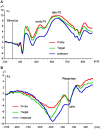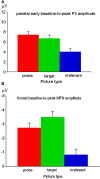"Have You Ever Seen This Face?" - Individual Differences and Event-Related Potentials during Deception
- PMID: 23267339
- PMCID: PMC3526901
- DOI: 10.3389/fpsyg.2012.00570
"Have You Ever Seen This Face?" - Individual Differences and Event-Related Potentials during Deception
Abstract
Deception studies emphasize on the importance of event-related potentials (ERP) for a reliable differentiation of the underlying neuro-cognitive processes. The stimulus-locked parietal P3 amplitude has been shown to reflect stimulus salience but also attentional control available for stimulus processing. Known stimuli requiring truthful responses (targets) and known stimuli requiring deceptive responses (probes) were hypothesized to be more salient than unknown stimuli. Thus, a larger P3 was predicted for known truthful and deceptive stimuli than for unknown stimuli. The Medial Frontal Negativity (MFN) represents the amount of required cognitive control and was expected to be more negative to known truthful and deceptive stimuli than to unknown stimuli. Moreover, we expected higher sensitivity to injustice (SI-perpetrator) and aversiveness (Trait-BIS) to result in more intense neural processes during deception. N = 102 participants performed a deception task with three picture types: probes requiring deceptive responses, targets requiring truthful responses to known stimuli, and irrelevants being associated with truthful responses to unknown stimuli. Repeated-measures ANOVA and fixed-links modeling suggested a more positive parietal P3 and a more negative frontal MFN to deceptive vs. irrelevant stimuli. Trait-BIS and SI-perpetrator predicted an increase of the P3 and a decrease of the MFN from irrelevants to probes. This suggested an intensification of stimulus salience and cognitive control across picture types in individuals scoring either higher on Trait-BIS or higher on SI-perpetrator. In contrast, individuals with both higher Trait-BIS and higher SI-perpetrator scores showed a less negative probe-MFN suggesting that this subgroup invests less cognitive control to probes. By extending prior research we demonstrate that personality modulates stimulus salience and control processes during deception.
Keywords: MFN; P3; deception; fixed-links modeling; individual differences.
Figures







References
-
- Allen J. J., Iacono W. G., Danielson K. D. (1992). The identification of concealed memories using the event-related potential and implicit behavioral measures: a methodology for prediction in the face of individual differences. Psychophysiology 29, 504–52210.1111/j.1469-8986.1992.tb02024.x - DOI - PubMed
-
- Amodio D. M., Master S. L., Yee C. M., Taylor S. E. (2008). Neurocognitive components of the behavioral inhibition and activation systems: implications for theories of self-regulation. Psychophysiology 45, 11–19 - PubMed
LinkOut - more resources
Full Text Sources
Miscellaneous

